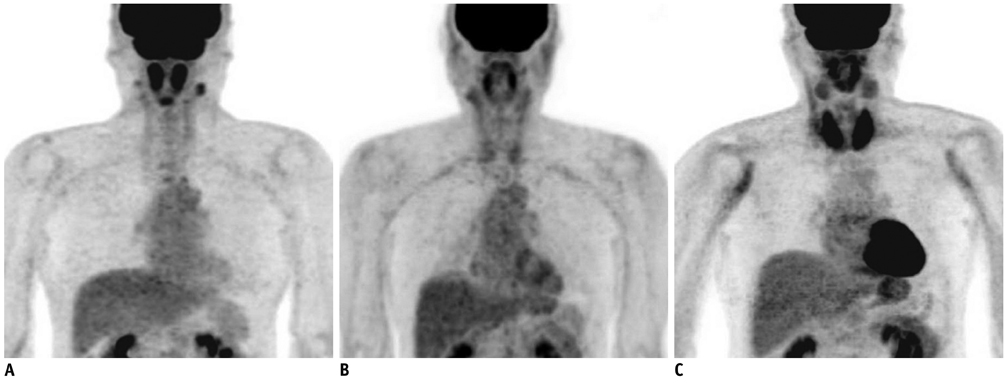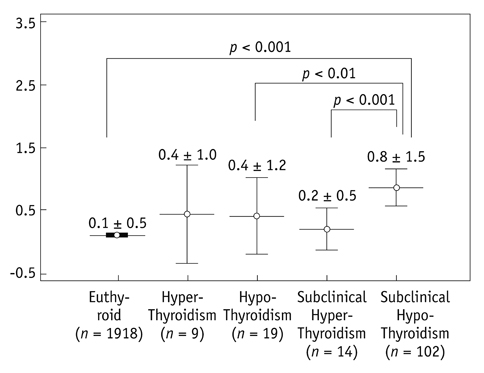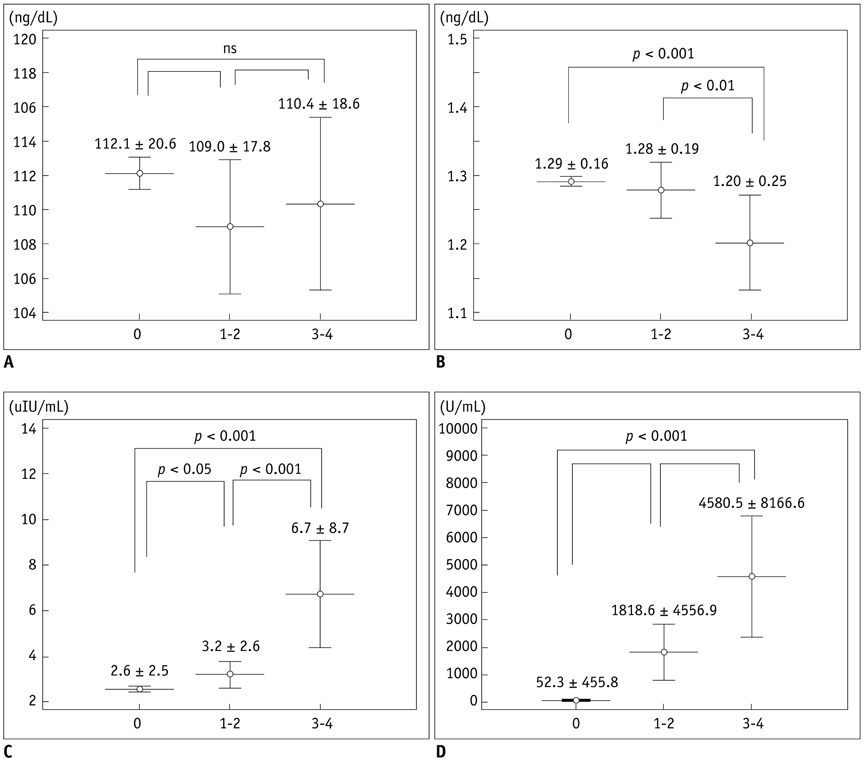Korean J Radiol.
2013 Jun;14(3):501-509. 10.3348/kjr.2013.14.3.501.
Diffuse Thyroid Uptake Incidentally Found on 18F-Fluorodeoxyglucose Positron Emission Tomography in Subjects without Cancer History
- Affiliations
-
- 1Department of Nuclear Medicine, CHA Bundang Medical Center, CHA University, Seongnam 463-712, Korea.
- 2Department of Nuclear Medicine, Samsung Medical Center, Sungkyunkwan University School of Medicine, Seoul 135-710, Korea. jynm.choi@samsung.com
- 3Center for Health Promotion, Samsung Medical Center, Sungkyunkwan University School of Medicine, Seoul 135-710, Korea.
- KMID: 1705467
- DOI: http://doi.org/10.3348/kjr.2013.14.3.501
Abstract
OBJECTIVE
We investigated the clinical significance of incidental diffuse thyroid uptake (DTU) on 18F-FDG PET in subjects without a history of cancer.
MATERIALS AND METHODS
This study included 2062 studies from adults who underwent 18F-FDG PET as a cancer screening program. Subjects were divided into the following two groups: with (group I) or without (group II) DTU. The presence of DTU and the thyroid visual grading score were compared with thyroid function tests, serum anti-microsomal antibody (AMA) levels, and the presence of diffuse parenchymal change (DPC) on ultrasonography (USG).
RESULTS
DTU was found in 6.6% of the scans (137/2062). Serum thyroid stimulating hormone (TSH) and AMA levels were significantly higher in group I than in group II. Increased AMA level (55.1%) and DPC (48.7%) were more frequently found in group I (p < 0.001). The proportion of subjects with any abnormal results in serum free thyroxine, triiodothyronine, TSH, or AMA levels or DPC on USG was significantly higher in group I than in group II (71.5% vs. 10.6%, p < 0.001), and was significantly and gradually increased according to the visual grading score group (0 vs. 1-2 vs. 3-4 = 10.6% vs. 58.5% vs. 90.9%, p < 0.001). TSH and is AMA levels were significantly increased according to the visual grading score.
CONCLUSION
The presence or degree of incidental DTU on 18F-FDG PET is closely correlated with increased serum AMA and TSH levels, and the presence of DPC on USG. Therefore, the most plausible pathological cause of DTU may be cell damage by an autoimmune mechanism.
Keyword
MeSH Terms
-
Adult
Aged
Aged, 80 and over
Antibodies/blood
Female
Fluorodeoxyglucose F18/*diagnostic use/pharmacokinetics
Humans
*Incidental Findings
Male
Microsomes/immunology
Middle Aged
Neoplasms
Positron-Emission Tomography/methods
Radiopharmaceuticals/*diagnostic use/pharmacokinetics
Retrospective Studies
Thyroid Gland/metabolism/*radionuclide imaging/ultrasonography
Thyrotropin/blood
Young Adult
Antibodies
Fluorodeoxyglucose F18
Radiopharmaceuticals
Thyrotropin
Figure
Reference
-
1. Fletcher JW, Djulbegovic B, Soares HP, Siegel BA, Lowe VJ, Lyman GH, et al. Recommendations on the use of 18F-FDG PET in oncology. J Nucl Med. 2008. 49:480–508.2. Nabi HA, Zubeldia JM. Clinical applications of (18)F-FDG in oncology. J Nucl Med Technol. 2002. 30:3–9. quiz 10-11.3. Ko DH, Choi JY, Song YM, Lee SJ, Kim YH, Lee KH, et al. The usefulness of 18F-FDG PET as a cancer screening test. Nucl Med Mol Imaging. 2008. 42:444–450.4. Chung JI, Cho HB, Shim JY, Choi Y, Lee KH, Kim BT, et al. Detection of cancer with PET and PET/CT in asymptomatic volunteers. Nucl Med Mol Imaging. 2009. 43:526–534.5. Choi JY, Lee KS, Kwon OJ, Shim YM, Baek CH, Park K, et al. Improved detection of second primary cancer using integrated [18F] fluorodeoxyglucose positron emission tomography and computed tomography for initial tumor staging. J Clin Oncol. 2005. 23:7654–7659.6. Lim I, Lee WW, Chung JH, Park SY, Kim SH, Kim YK, et al. Incidental benign parotid lesions on FDG PET: Prevalence and clinico-pathologic findings. Nucl Med Mol Imaging. 2007. 41:359–363.7. Bae JS, Chae BJ, Park WC, Kim JS, Kim SH, Jung SS, et al. Incidental thyroid lesions detected by FDG-PET/CT: prevalence and risk of thyroid cancer. World J Surg Oncol. 2009. 7:63.8. Choi JY, Lee KS, Kim HJ, Shim YM, Kwon OJ, Park K, et al. Focal thyroid lesions incidentally identified by integrated 18F-FDG PET/CT: clinical significance and improved characterization. J Nucl Med. 2006. 47:609–615.9. Cohen MS, Arslan N, Dehdashti F, Doherty GM, Lairmore TC, Brunt LM, et al. Risk of malignancy in thyroid incidentalomas identified by fluorodeoxyglucose-positron emission tomography. Surgery. 2001. 130:941–946.10. Kim TY, Kim WB, Ryu JS, Gong G, Hong SJ, Shong YK. 18F-fluorodeoxyglucose uptake in thyroid from positron emission tomogram (PET) for evaluation in cancer patients: high prevalence of malignancy in thyroid PET incidentaloma. Laryngoscope. 2005. 115:1074–1078.11. Shie P, Cardarelli R, Sprawls K, Fulda KG, Taur A. Systematic review: prevalence of malignant incidental thyroid nodules identified on fluorine-18fluorodeoxyglucose positron emission tomography. Nucl Med Commun. 2009. 30:742–748.12. Chen W, Parsons M, Torigian DA, Zhuang H, Alavi A. Evaluation of thyroid FDG uptake incidentally identified on FDG-PET/CT imaging. Nucl Med Commun. 2009. 30:240–244.13. Kurata S, Ishibashi M, Hiromatsu Y, Kaida H, Miyake I, Uchida M, et al. Diffuse and diffuse-plus-focal uptake in the thyroid gland identified by using FDG-PET: prevalence of thyroid cancer and Hashimoto's thyroiditis. Ann Nucl Med. 2007. 21:325–330.14. Yasuda S, Shohtsu A, Ide M, Takagi S, Takahashi W, Suzuki Y, et al. Chronic thyroiditis: diffuse uptake of FDG at PET. Radiology. 1998. 207:775–778.15. Chen YK, Chen YL, Cheng RH, Yeh CL, Lee CC, Hsu CH. The significance of FDG uptake in bilateral thyroid glands. Nucl Med Commun. 2007. 28:117–122.16. Karantanis D, Bogsrud TV, Wiseman GA, Mullan BP, Subramaniam RM, Nathan MA, et al. Clinical significance of diffusely increased 18F-FDG uptake in the thyroid gland. J Nucl Med. 2007. 48:896–901.17. Liu Y. Clinical significance of thyroid uptake on F18-fluorodeoxyglucose positron emission tomography. Ann Nucl Med. 2009. 23:17–23.18. Rothman IN, Middleton L, Stack BC Jr, Bartel T, Riggs AT, Bodenner DL. Incidence of diffuse FDG uptake in the thyroid of patients with hypothyroidism. Eur Arch Otorhinolaryngol. 2011. 268:1501–1504.19. Wolf G, Aigner RM, Schaffler G, Schwarz T, Krippl P. Pathology results in [18F]fluorodeoxyglucose positron emission tomography of the thyroid gland. Nucl Med Commun. 2003. 24:1225–1230.20. Kang KW, Kim SK, Kang HS, Lee ES, Sim JS, Lee IG, et al. Prevalence and risk of cancer of focal thyroid incidentaloma identified by 18F-fluorodeoxyglucose positron emission tomography for metastasis evaluation and cancer screening in healthy subjects. J Clin Endocrinol Metab. 2003. 88:4100–4104.21. Cho YS, Choi JY, Lee SJ, Hyun SH, Lee JY, Choi Y, et al. Clinical significance of focal breast lesions incidentally identified by 18F-FDG PET/CT. Nucl Med Mol Imaging. 2008. 42:456–463.22. Hyun SH, Choi JY, Lee KH, Choe YS, Kim BT. Incidental focal 18F-FDG uptake in the pituitary gland: clinical significance and differential diagnostic criteria. J Nucl Med. 2011. 52:547–550.23. Kang BJ, O JH, Baik JH, Jung SL, Park YH, Chung SK. Incidental thyroid uptake on F-18 FDG PET/CT: correlation with ultrasonography and pathology. Ann Nucl Med. 2009. 23:729–737.24. Boerner AR, Voth E, Theissen P, Wienhard K, Wagner R, Schicha H. Glucose metabolism of the thyroid in Graves' disease measured by F-18-fluoro-deoxyglucose positron emission tomography. Thyroid. 1998. 8:765–772.25. Chistiakov DA. Immunogenetics of Hashimoto's thyroiditis. J Autoimmune Dis. 2005. 2:1.26. Barbesino G, Tomer Y, Concepcion ES, Davies TF, Greenberg DA. International Consortium for the Genetics of Autoimmune Thyroid Disease. Linkage analysis of candidate genes in autoimmune thyroid disease. II. Selected gender-related genes and the X-chromosome. J Clin Endocrinol Metab. 1998. 83:3290–3295.27. Cutolo M, Sulli A, Seriolo B, Accardo S, Masi AT. Estrogens, the immune response and autoimmunity. Clin Exp Rheumatol. 1995. 13:217–226.28. Ahmed SA, Hissong BD, Verthelyi D, Donner K, Becker K, Karpuzoglu-Sahin E. Gender and risk of autoimmune diseases: possible role of estrogenic compounds. Environ Health Perspect. 1999. 107:Suppl 5. 681–686.
- Full Text Links
- Actions
-
Cited
- CITED
-
- Close
- Share
- Similar articles
-
- Lymphocytic Thyroiditis Presenting as a Focal Uptake on 18F-Fluorodeoxyglucose Positron Emission Tomography: A Case Report
- Clinical Meaning of Incidental Thyroid Uptake on F-18 FDG PET-CT
- A non-functioning pituitary macroadenoma detected incidentally with PET-CT
- Characteristics of thyroid incidentalomas detected by pre-treatment [18F]FDG PET or PET/CT in patients with cervical cancer
- Perirenal 18F-FDG Uptake in a Patient with a Pheochromocytoma




